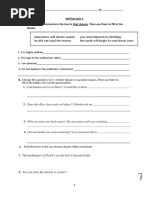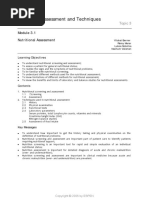0 ratings0% found this document useful (0 votes)
6 viewsUnit 4: Identifying The Pattern
Unit 4: Identifying The Pattern
Uploaded by
Meow MemyselfThe document discusses various patterns related to trash and waste. It describes how in the US, homeless people search trash for food and clothes, while in developing countries people collect trash from dumps to sell. It also mentions how old computers are sometimes reused or recycled, but also exported to developing countries. The document also discusses historical patterns of trash disposal, from leaving it wherever to now most people taking it home or dumping in the ocean.
Copyright:
© All Rights Reserved
Available Formats
Download as PPTX, PDF, TXT or read online from Scribd
Unit 4: Identifying The Pattern
Unit 4: Identifying The Pattern
Uploaded by
Meow Memyself0 ratings0% found this document useful (0 votes)
6 views17 pagesThe document discusses various patterns related to trash and waste. It describes how in the US, homeless people search trash for food and clothes, while in developing countries people collect trash from dumps to sell. It also mentions how old computers are sometimes reused or recycled, but also exported to developing countries. The document also discusses historical patterns of trash disposal, from leaving it wherever to now most people taking it home or dumping in the ocean.
Original Description:
answer
Original Title
411 711 K12
Copyright
© © All Rights Reserved
Available Formats
PPTX, PDF, TXT or read online from Scribd
Share this document
Did you find this document useful?
Is this content inappropriate?
The document discusses various patterns related to trash and waste. It describes how in the US, homeless people search trash for food and clothes, while in developing countries people collect trash from dumps to sell. It also mentions how old computers are sometimes reused or recycled, but also exported to developing countries. The document also discusses historical patterns of trash disposal, from leaving it wherever to now most people taking it home or dumping in the ocean.
Copyright:
© All Rights Reserved
Available Formats
Download as PPTX, PDF, TXT or read online from Scribd
Download as pptx, pdf, or txt
0 ratings0% found this document useful (0 votes)
6 views17 pagesUnit 4: Identifying The Pattern
Unit 4: Identifying The Pattern
Uploaded by
Meow MemyselfThe document discusses various patterns related to trash and waste. It describes how in the US, homeless people search trash for food and clothes, while in developing countries people collect trash from dumps to sell. It also mentions how old computers are sometimes reused or recycled, but also exported to developing countries. The document also discusses historical patterns of trash disposal, from leaving it wherever to now most people taking it home or dumping in the ocean.
Copyright:
© All Rights Reserved
Available Formats
Download as PPTX, PDF, TXT or read online from Scribd
Download as pptx, pdf, or txt
You are on page 1of 17
UNIT 4
Identifying the Pattern
1. in U.S., some people make a living from
trash
2. in American and European cities, homeless
people look for food and clothes in trash
cans
3. in developing countries, people collect
trash in garbage dumps and sell it
Signal words/phrases: some, also, for
example
1. millions of computers thrown into trash,
end up in dumps
2. some computers brought to recycling
centers
3. specialized companies take some
computers apart and reuse parts
4. some computers sent to developing
countries
Signal words/phrases: A certain number,
Other, Sometimes, Other
1. in early years things left where they were
2. some visitors put trash in hole in the
ground
3. most now take trash home
4. some dump trash into the ocean
Signal words/phrases: many, Some, Most, a
certain number of
3. 3. Supporting facts and ideas:
1. born in 1919
2. family moved to California
3. older brother became track star
4. in high school most valuable player
5. at U.C. played four sports
6. left U.C. in 1941
1. joined the U.S. Army
2. blacks separate from whites on buses valuable
player
3. R. refused to move to back of army bus
4. R. was arrested
5. army recognized R. was right
6. war was almost over
1. career began with Montreal Royals
2. had trouble because he was the only black
player
3. moved to major leagues Brooklyn Dodgers
4. awarded prize for best young player
5. Dodgers most valuable player
3. Supporting facts and ideas:
1. choose a book
2. make notes
3. practice talking from notes
4. time yourself
5. practice talk with a friend or record it
3. Supporting facts and ideas:
1. buy several kinds of meat
2. put meat in large pot and add water
3. add carrots, celery, and parsley
4. put broth on stove
5. turn heat down and let it cook
3. Supporting facts and ideas:
1. setting in U.S. is campus; setting in Italy is city
2. American universities have green space; Italian
universities do not
3. American students live in dorms; Italian students
live at home or in apartments
3. Supporting facts and ideas:
1. universities in both countries have course
requirements
2. in Italy, students courses in chosen field
3. in U.S., students take courses outside major
4. Italian students not required to attend classes
5. American students required to attend classes
3. Supporting facts and ideas:
1. travellers arrive in new place with germs
2. people have no protection, so catch disease
3. disease not identified, so no measures taken
4. disease spreads through population
3. Supporting facts and ideas:
1. air conditioners are a common source of health
problems (germs grow in them and are blown
into homes and offices)
2. heating/cooling systems of large buildings can
also cause illness (germs grow in cooling towers
and are sent through buildings with air
conditioning)
3. Supporting facts and ideas:
1. pollution caused by chemicals or human waste
2. pollutants result in algae growth, habitat for
cholera
3. algae and cholera stick to ship bottoms and
travel around world
3. Supporting facts and ideas:
1. many people in developing countries dont have
electricity, so they cant keep food fresh in hot
weather
2. a new kind of cooler is made of two clay pots
with wet sand and wet cloth
3. useful for developing countries since easy,
inexpensive, doesnt require ice or electricity
Two Content Layout with Table
Group A
Group B
Class 1
82
85
Class 2
76
88
Class 3
84
90
FIRST BULLET POINT
HERE
SECOND BULLET
POINT HERE
THIRD BULLET POINT
HERE
Two Content Layout with SmartArt
First bullet point here
Group A
Second bullet point
here
Task 1
Task 2
Third bullet point here
Group B
Task 1
Task 2
Group C
Task 1
You might also like
- 04 - Answer Key For Weaving It Together 2Document10 pages04 - Answer Key For Weaving It Together 2Aymen Al-badani85% (33)
- AP Human Geography Notes Chapter 4Document8 pagesAP Human Geography Notes Chapter 4Charlotte T Hong100% (4)
- Parts Manual: Issue 13Document141 pagesParts Manual: Issue 13Юра ПименовNo ratings yet
- English 5 Quarter 2 Week 1 - Day-2Document26 pagesEnglish 5 Quarter 2 Week 1 - Day-2Maribel ArellanoNo ratings yet
- Chapter 4Document5 pagesChapter 4Nguyễn Thanh TuyềnNo ratings yet
- Extensive Reading Activities PDFDocument13 pagesExtensive Reading Activities PDFMeow Memyself50% (6)
- Vilistus ManualDocument104 pagesVilistus Manualmy_Scribd_pseudoNo ratings yet
- Grade 5 English Reading Identifying The Key Sentence in A ParagraphDocument4 pagesGrade 5 English Reading Identifying The Key Sentence in A ParagraphEickcam Labecrab50% (2)
- Ingles 1Document10 pagesIngles 1ruth.diaz16No ratings yet
- Cuf-Reading Material (Feb.02, 2024)Document5 pagesCuf-Reading Material (Feb.02, 2024)santa nina marjesNo ratings yet
- Learner'S Materials: Week 3Document13 pagesLearner'S Materials: Week 3Allen Jay Araneta BejeranoNo ratings yet
- Meeting 6 Textual Reading (Topic)Document7 pagesMeeting 6 Textual Reading (Topic)cucuapriantisasing1403No ratings yet
- Speak Up in Class Nº446 (10-2022)Document7 pagesSpeak Up in Class Nº446 (10-2022)yanosveremos21No ratings yet
- DAY 3 OUTPUTS RenabethDocument2 pagesDAY 3 OUTPUTS RenabethRenabeth CastroNo ratings yet
- Final Revision P.3 2023-2024Document21 pagesFinal Revision P.3 2023-2024mostafamoh.20090No ratings yet
- Toefl Exercise For Skill 1: Sample Passage and QuestionsDocument5 pagesToefl Exercise For Skill 1: Sample Passage and QuestionsKhomsiatul MunawarohNo ratings yet
- IELTS 5.0 - L5 - R - DoneDocument13 pagesIELTS 5.0 - L5 - R - Donengodung.cleverlearnNo ratings yet
- Writing 3 Self Study 2Document5 pagesWriting 3 Self Study 2Nguyen ChloeNo ratings yet
- UCSP Module 4 - ActivitiesDocument2 pagesUCSP Module 4 - ActivitiesTeds TV100% (2)
- The Importance of Trees: Writing Test: Task 1 - Filling The GapsDocument5 pagesThe Importance of Trees: Writing Test: Task 1 - Filling The GapsNhung ĐặngNo ratings yet
- 2 Achievements of Scientiests in Chemistry and Related TechnologyDocument4 pages2 Achievements of Scientiests in Chemistry and Related TechnologyCris CorsinoNo ratings yet
- Chapter 6Document21 pagesChapter 6pitchapapa siridetkoonNo ratings yet
- Class 4 Evs NovDocument10 pagesClass 4 Evs Novanita.pariharNo ratings yet
- Video How To SleepDocument2 pagesVideo How To Sleepjosect2No ratings yet
- Đề 1Document11 pagesĐề 1ptlien290329No ratings yet
- Module in Science 4Document10 pagesModule in Science 4livy malayoNo ratings yet
- De Hoc Sinh Gioi Tinh Tieng Anh 11 Chuyen Nam 2020 2021 So GDDT Lang SonDocument16 pagesDe Hoc Sinh Gioi Tinh Tieng Anh 11 Chuyen Nam 2020 2021 So GDDT Lang SonNgọc Khánh NguyễnNo ratings yet
- Academic Writing AssignmentDocument13 pagesAcademic Writing AssignmentazkhazNo ratings yet
- Screenshot 2023-11-04 at 9.10.35 AMDocument11 pagesScreenshot 2023-11-04 at 9.10.35 AMthanthansint.mtla2023No ratings yet
- Practice 1 ZakiDocument12 pagesPractice 1 ZakiJundi ArzakiNo ratings yet
- First Periodical Test-SCIENCE 4Document3 pagesFirst Periodical Test-SCIENCE 4Hannah June RodriguezNo ratings yet
- WB 5-6-7 InterchangeDocument6 pagesWB 5-6-7 InterchangeWilliam AbarcaNo ratings yet
- Part 2Document4 pagesPart 2Đức MinhNo ratings yet
- 3 The Making of A Global WorldDocument14 pages3 The Making of A Global WorldjaatfmdNo ratings yet
- Pair Discussion - Introductory Paragraph and Thesis Statement ANSWER KEYDocument3 pagesPair Discussion - Introductory Paragraph and Thesis Statement ANSWER KEYTika Virginiya100% (1)
- Aptis Reading Test 4Document8 pagesAptis Reading Test 4English Luz HurtadoNo ratings yet
- High School Reading Test SerdarSoyer Hasan Şerif Baltacı Önder Barış Öztürk Rabia Gonca AslanDocument6 pagesHigh School Reading Test SerdarSoyer Hasan Şerif Baltacı Önder Barış Öztürk Rabia Gonca AslanÖnder Barış ÖztürkNo ratings yet
- Js 1 3rd Term H-Econs E-NotesDocument35 pagesJs 1 3rd Term H-Econs E-NotesGloria Ngeri Dan-Orawari75% (4)
- 1 BASIC PARAGRAPH ShortDocument11 pages1 BASIC PARAGRAPH ShortDoan NguyenNo ratings yet
- 1st Summative Test Quarter2Document15 pages1st Summative Test Quarter2Andrew Pov A. RamelNo ratings yet
- S9 Q3 Week-7Document11 pagesS9 Q3 Week-7acenvince9No ratings yet
- Latest Reading QuestionsDocument8 pagesLatest Reading Questionsbiniammebrate9No ratings yet
- Values 3 QA 3rd Quarter ReviewerDocument2 pagesValues 3 QA 3rd Quarter ReviewerkathrinejanecaseraaNo ratings yet
- Eapp Q3 W5 Updated OutliningDocument15 pagesEapp Q3 W5 Updated OutliningShaniah AleaNo ratings yet
- nghrDocument3 pagesnghrmaithitotrinh.06No ratings yet
- Test Listening and ReadingDocument7 pagesTest Listening and ReadingK59 DINH NGOC ANHNo ratings yet
- Mariangel Amin and Julian MendezDocument3 pagesMariangel Amin and Julian Mendezjema712No ratings yet
- W4-SCIENCE Grade 5Document56 pagesW4-SCIENCE Grade 5Gladish AnsubanNo ratings yet
- Class 6 ScienceDocument16 pagesClass 6 Sciencevarunreddy26082012No ratings yet
- Listening 24 TH NovemberDocument3 pagesListening 24 TH NovemberSanty M . E . :vNo ratings yet
- Bài học LMS 30_10_24 (1)Document32 pagesBài học LMS 30_10_24 (1)Nguyễn Nhật TríNo ratings yet
- P4 Social Studies Task 2 April 2020Document4 pagesP4 Social Studies Task 2 April 2020lidya AnggrainiNo ratings yet
- Pioneer Lesson Plans and Actvities ComDocument30 pagesPioneer Lesson Plans and Actvities Comapi-287939667100% (1)
- OA1 3b readingAnswerKeyDocument8 pagesOA1 3b readingAnswerKeymafalda1286100% (1)
- Summary of American Civilization 6-10Document54 pagesSummary of American Civilization 6-10Nguyễn Đức DũngNo ratings yet
- UNIT 4 Paragraph StructureDocument7 pagesUNIT 4 Paragraph StructureAkhid MaulanaNo ratings yet
- Muhammad Alhady (Developing A Paragraph Answer)Document4 pagesMuhammad Alhady (Developing A Paragraph Answer)Euthana siaNo ratings yet
- De Luyen Thi Tieng Anh Vao Lop 6 Truong THPT Chuyen Ha Noi AmsterdamDocument12 pagesDe Luyen Thi Tieng Anh Vao Lop 6 Truong THPT Chuyen Ha Noi AmsterdamMinh Khánh VũNo ratings yet
- Reading: Bộ Đề Ôn Tập Tiếng Anh 9 Đủ Các Dạng Có Đáp ÁnDocument84 pagesReading: Bộ Đề Ôn Tập Tiếng Anh 9 Đủ Các Dạng Có Đáp ÁnDuong ThuyNo ratings yet
- Where Is Chicago in The United States?Document4 pagesWhere Is Chicago in The United States?Kyelenny LucianoNo ratings yet
- Unit 3-Supporting Sentences (Week 3&4&5)Document21 pagesUnit 3-Supporting Sentences (Week 3&4&5)Aquarius Ck NgokNo ratings yet
- B1 PDFDocument9 pagesB1 PDFAnthony Ash EstradaNo ratings yet
- Introduce YourselfDocument1 pageIntroduce YourselfMeow MemyselfNo ratings yet
- The First Advice Is TimeDocument2 pagesThe First Advice Is TimeMeow MemyselfNo ratings yet
- Writing Quiz 2 A. Change The Statements in The Box To That Clauses. Then Use Them To Fill in The BlanksDocument4 pagesWriting Quiz 2 A. Change The Statements in The Box To That Clauses. Then Use Them To Fill in The BlanksMeow MemyselfNo ratings yet
- Educational Game-Based Training (EGT) For Enhancing Ethics in Academic Writing in EFL ContextDocument1 pageEducational Game-Based Training (EGT) For Enhancing Ethics in Academic Writing in EFL ContextMeow MemyselfNo ratings yet
- Reducing Plagiarism Rate With A GameDocument2 pagesReducing Plagiarism Rate With A GameMeow MemyselfNo ratings yet
- Have Surveyed: InvestigateDocument2 pagesHave Surveyed: InvestigateMeow MemyselfNo ratings yet
- Finishing Unit 2: Finding The LinksDocument10 pagesFinishing Unit 2: Finding The LinksMeow MemyselfNo ratings yet
- EFL Classes: Diverse Aspects of Learning and TeachingDocument6 pagesEFL Classes: Diverse Aspects of Learning and TeachingMeow MemyselfNo ratings yet
- Pre Conference Thailand TESOL 2016 "The Changing Landscape of ELT: Empowerment Through Glocalization"Document1 pagePre Conference Thailand TESOL 2016 "The Changing Landscape of ELT: Empowerment Through Glocalization"Meow MemyselfNo ratings yet
- January 2017: NotesDocument12 pagesJanuary 2017: NotesMeow MemyselfNo ratings yet
- Tape Script 1 (Chapter 1)Document7 pagesTape Script 1 (Chapter 1)Meow MemyselfNo ratings yet
- Worksheet B: Applicant InterviewerDocument2 pagesWorksheet B: Applicant InterviewerMeow MemyselfNo ratings yet
- Gender Issues in ASEAN: Your Logo HereDocument27 pagesGender Issues in ASEAN: Your Logo HereMeow MemyselfNo ratings yet
- Worksheet A: Interviewer Applicant .Document2 pagesWorksheet A: Interviewer Applicant .Meow MemyselfNo ratings yet
- @pullman Khon Kaen Raja Orchid Hotel Khon Kaen, Thailand.: Participant FormDocument2 pages@pullman Khon Kaen Raja Orchid Hotel Khon Kaen, Thailand.: Participant FormMeow MemyselfNo ratings yet
- More Awareness To Gender Issues Urged in ASEANDocument1 pageMore Awareness To Gender Issues Urged in ASEANMeow MemyselfNo ratings yet
- Worksheet 1 (B and P) : Name .. NoDocument2 pagesWorksheet 1 (B and P) : Name .. NoMeow MemyselfNo ratings yet
- Urbs and Suburbs - Student's VersionDocument7 pagesUrbs and Suburbs - Student's VersionLucia SanchezNo ratings yet
- CG Question 567Document1 pageCG Question 567Maryam MalikNo ratings yet
- NN Assignment PDFDocument3 pagesNN Assignment PDFMalika ShresthaNo ratings yet
- Molan 2009Document7 pagesMolan 2009Tya RaNo ratings yet
- Ensuring The Financial Sustainability of Business EntitiesDocument3 pagesEnsuring The Financial Sustainability of Business Entitiesresearchparks100% (1)
- s550 It4 Maintenance ChartDocument1 pages550 It4 Maintenance ChartMohamed ZakiNo ratings yet
- Decentring Leisure - Rethinking Leisure Theory (PDFDrive)Document224 pagesDecentring Leisure - Rethinking Leisure Theory (PDFDrive)Andy LeerNo ratings yet
- Business ResearchDocument6 pagesBusiness ResearchBernard calapuanNo ratings yet
- Antenna Colinear ZeppDocument3 pagesAntenna Colinear ZeppRick LongestNo ratings yet
- Mil PRF 680CDocument12 pagesMil PRF 680CfltpNo ratings yet
- YanyanDocument3 pagesYanyanArceli B. RubinoNo ratings yet
- Streptococcus Pneumonae: Pathophysiology of CopdDocument1 pageStreptococcus Pneumonae: Pathophysiology of CopdDimpal ChoudharyNo ratings yet
- Daewoo AC ManualDocument19 pagesDaewoo AC ManualwfettichNo ratings yet
- Flyer UNO Hattenbach TrokarDocument1 pageFlyer UNO Hattenbach Trokarophtho india incNo ratings yet
- ResearchDocument19 pagesResearchearl alealeNo ratings yet
- 03 - Nutritional Screening and Assessment PDFDocument8 pages03 - Nutritional Screening and Assessment PDFbocah_britpop100% (1)
- Strapped: by Nina G. JonesDocument59 pagesStrapped: by Nina G. JonesLoloNo ratings yet
- Selecting The Correct Concentrate Launder DesignDocument2 pagesSelecting The Correct Concentrate Launder DesignMahlatse Mogashoa0% (1)
- Masonry Cement: Standard Specification ForDocument6 pagesMasonry Cement: Standard Specification Forعمر عمرNo ratings yet
- Achiever 8 March SolDocument11 pagesAchiever 8 March SolRishiNo ratings yet
- Ice - CreamDocument72 pagesIce - CreamAshish Sheth100% (1)
- The Green Man - Reading CompDocument2 pagesThe Green Man - Reading CompadideoNo ratings yet
- Kepadatan Dan Pola Distribusi Gastropoda PDFDocument11 pagesKepadatan Dan Pola Distribusi Gastropoda PDFMahdeeNo ratings yet
- Cardiac ImagingDocument118 pagesCardiac ImagingSay DieukayNo ratings yet
- Comparison of Constitutive Soil Models in Predicting MovementsDocument11 pagesComparison of Constitutive Soil Models in Predicting MovementsM SNo ratings yet
- Mutual FundsDocument48 pagesMutual FundsTony StarkNo ratings yet
- Shell Script To Find Prime Factors of A NumberDocument4 pagesShell Script To Find Prime Factors of A NumberkvsrvzmNo ratings yet










































































































